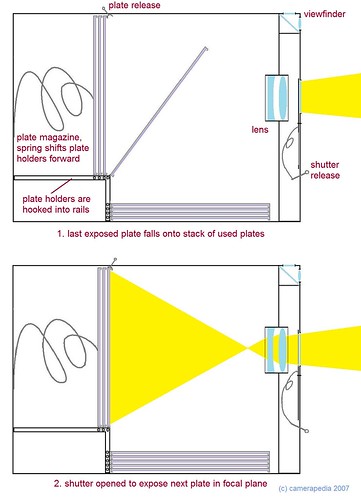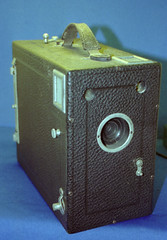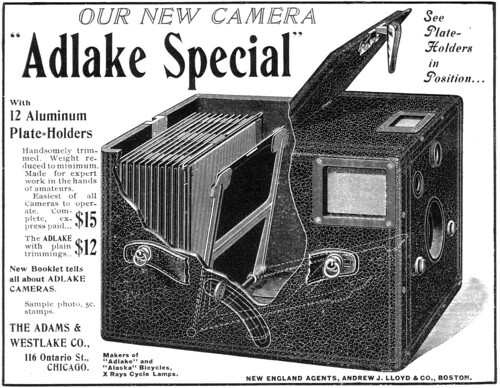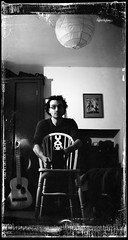Difference between revisions of "Magazine camera"
m (→Links) |
m (Moved Glossary to the top of the page) |
||
| (16 intermediate revisions by 7 users not shown) | |||
| Line 1: | Line 1: | ||
| + | {{glossary}} | ||
===The two main types of magazine cameras=== | ===The two main types of magazine cameras=== | ||
| − | In the 1890s a new type of camera became popular: The '''magazine camera'''. This type of large [[box camera]] allowed to make a series of 8 to 12 exposures on medium or large format glass plates or film sheets without reloading. That was quite convenient by means of more or less helpful mechanical plate changing facilities. The camera | + | <div class="floatright plainlinks">[http://www.flickr.com/photos/uwe_kulick/2803317471/in/pool-camerawiki http://farm4.static.flickr.com/3277/2803317471_0db53a2fdd_m.jpg]<br/>falling plate camera [[Chic]] {{public domain}}</div>In the 1890s a new type of camera became popular: The '''magazine camera'''. This type of large [[box camera]] allowed to make a series of 8 to 12 exposures on medium or large format glass plates or film sheets without reloading. That was quite convenient by means of more or less helpful mechanical plate changing facilities. The camera engineers developed a great variety of easy plate change mechanisms. The cameras were loaded with a set of tin plate holders or tin film sheet holders. Of course each holder had to be loaded with a film sheet or a sensitized glass plate before. The term "falling plate camera" stands for a quite exciting subtype of these cameras: The holders of used plates fell face down onto a stack on the camera bottom, or an unused plate fell from the stack below the camera top into focal plane position before exposure. Therefore the plate holders were hooked into rails so that they ever moved and fell into the right place. These magazine cameras had to be loaded in the dark room or dark tent. |
| − | Another type of magazine camera was loadable in daylight. It had to be loaded with a set of light proof covered plate holders or sheet holders. Some of these cameras had a facility to open and to close the hinged front cover of the plate holder in focal plane. After closing its front cover the holder with the exposed plate was simply drawn out and shifted back | + | Another type of magazine camera was loadable in daylight. It had to be loaded with a set of light proof covered plate holders or sheet holders. Some of these cameras had a facility to open and to close the hinged front cover of the plate holder in focal plane. After closing its front cover the holder with the exposed plate was simply drawn out of the magazine, away from its first position in the queue, and then shifted into the back of the magazine, behind all the other plates. That way the next plate holder was shifted into the focal plane. The most renowned maker of such magazine cameras was the train-lantern and camera maker [[Adams & Westlake]]. |
| − | The typical magazine camera is equipped with two built-in reflecting type [[viewfinder]]s, one as waist-level finder for vertical format shots, the other as waist-level finder for horizontal format shots. That's like the finder equipment of most box | + | The typical magazine camera is equipped with two built-in reflecting type [[viewfinder]]s, one as waist-level finder for vertical format shots, the other as waist-level finder for horizontal format shots. That's like the finder equipment of most [[box camera]]s, but most magazine camera finders have larger screens (or ocular lenses). Many of these cameras are equipped with a mechanical exposure counter. In spite of the missing ability of exact ground glass focusing, some of the magazine cameras are outfitted with superb lens types. Around the turn from the 19th to the 20th century these cameras were popular, but they were invented much earlier. It was John Benjamin Dancer from Manchester who received the first patent on a magazine camera in 1856. |
===Pictures of the falling plate type=== | ===Pictures of the falling plate type=== | ||
| Line 11: | Line 12: | ||
||cross section showing how it works | ||cross section showing how it works | ||
|- | |- | ||
| − | ||[http://www.flickr.com/photos/ | + | ||[http://www.flickr.com/photos/uwe_kulick/1555372550/in/pool-camerawiki http://farm3.static.flickr.com/2329/1555372550_a656d7a4e0.jpg] |
| − | ||[http://www.flickr.com/photos/ | + | {{Flickr_image_caption |
| + | |image_text= <small>if not marked otherwise</small> | ||
| + | |image_by= Uwe Kulick | ||
| + | |image_rights= (C) | ||
| + | }} | ||
| + | |||
| + | ||[http://www.flickr.com/photos/uwe_kulick/1964230801/in/pool-camerawiki http://farm3.static.flickr.com/2395/1964230801_db20b8c3c4.jpg] | ||
|}{{br}} | |}{{br}} | ||
{|class=plainlinks | {|class=plainlinks | ||
| − | |rowspan= | + | |rowspan=5 valign=top|[http://www.flickr.com/photos/uwe_kulick/1468985611/in/pool-camerawiki http://farm2.static.flickr.com/1029/1468985611_1864f2774e.jpg] |
<br/>Illustration from an old ad, showing the sophisticated falling plate | <br/>Illustration from an old ad, showing the sophisticated falling plate | ||
<br/>mechanism of the [[Conley Quick Shot]], with an internal lever. Maybe | <br/>mechanism of the [[Conley Quick Shot]], with an internal lever. Maybe | ||
<br/>the lever kept the used plates lying face down, or it was an aid for | <br/>the lever kept the used plates lying face down, or it was an aid for | ||
| − | <br/>something else. | + | <br/>something else.<br/> |
| − | ||[http://www.flickr.com/photos/ | + | {{Flickr_image |
| + | |image_source= http://www.flickr.com/photos/mattijsfotos/4656117732/in/pool-camerawiki | ||
| + | |image= http://farm5.staticflickr.com/4007/4656117732_f1f411d232_m.jpg | ||
| + | |image_align= left | ||
| + | |image_text= Houghton Ensign [[Klito]] 00 | ||
| + | |image_by= Mattijsje | ||
| + | |image_rights= (C) | ||
| + | }} | ||
| + | |||
| + | ||[http://www.flickr.com/photos/uwe_kulick/1555294874/in/pool-camerawiki http://farm3.static.flickr.com/2288/1555294874_3225b5687c_m.jpg] | ||
|- | |- | ||
|align=right|unknown maker, ca. 1910<br/> | |align=right|unknown maker, ca. 1910<br/> | ||
|- | |- | ||
| − | ||[[Houghton]] | + | || [[Houghton and Ensign|Houghtons]] 1912 magazine camera<br/>with superb [[Bausch & Lomb]] lens: |
| + | |- | ||
| + | ||[http://www.flickr.com/photos/uwe_kulick/1468973397/in/pool-camerawiki http://farm2.static.flickr.com/1174/1468973397_376b9b8b6c_m.jpg] | ||
|- | |- | ||
| − | || | + | ||{{Flickr_image |
| + | |image_source= http://www.flickr.com/photos/damienstorey/4483973142/in/pool-camerawiki | ||
| + | |image= http://farm5.staticflickr.com/4048/4483973142_bd2a20ea53_m.jpg | ||
| + | |image_align= left | ||
| + | |image_text= <small>imaging sample on [[120 film]] made<br/>with no-name falling-plate camera</small> | ||
| + | |image_by= Damien Storey | ||
| + | |image_rights= (C) | ||
| + | }} | ||
|} | |} | ||
===Pictures of the daylight loading type=== | ===Pictures of the daylight loading type=== | ||
{| | {| | ||
| − | ||[http://www.flickr.com/photos/efo/235681371/in/pool- | + | ||[http://www.flickr.com/photos/efo/235681371/in/pool-camerawiki http://farm1.static.flickr.com/83/235681371_915946deba.jpg] |
|- | |- | ||
| − | Adams & Westlake's popular versatile ''Adlake Special'' | + | Adams & Westlake's popular versatile ''Adlake Special'' <br/><small>image by {{image author|Eben Ostby}}</small> {{non-commercial}} |
|- | |- | ||
||An old ad shows the H-shaped plate holder cover opening lever inside the camera: | ||An old ad shows the H-shaped plate holder cover opening lever inside the camera: | ||
|- | |- | ||
| − | ||[http://www.flickr.com/photos/ | + | ||[http://www.flickr.com/photos/uwe_kulick/1800078521/in/pool-camerawiki http://farm3.static.flickr.com/2050/1800078521_13b9c362fd.jpg] |
|} | |} | ||
| − | + | ==Links== | |
| − | *[http://licm.org.uk/livingImage/ | + | *[http://licm.org.uk/livingImage/Ensign_Midg.html Butcher's Midg of 1905] at [http://licm.org.uk Living Image Museum] |
| − | *[http://www. | + | *[http://www.piercevaubel.com/cam/catalogs/1898cyclonelp810.htm Western Camera Mfg. Co.'s Cyclone camera] at [http://www.piercevaubel.com/cam/index.htm Mathew Brady's website] |
| − | |||
| − | [[Category:Magazine | + | [[Category:Magazine cameras|*]] |
[[Category:Box]] | [[Category:Box]] | ||
| − | + | [[Category: Camera architecture]] | |
| − | |||
Latest revision as of 03:37, 23 March 2023
Contents
The two main types of magazine cameras
In the 1890s a new type of camera became popular: The magazine camera. This type of large box camera allowed to make a series of 8 to 12 exposures on medium or large format glass plates or film sheets without reloading. That was quite convenient by means of more or less helpful mechanical plate changing facilities. The camera engineers developed a great variety of easy plate change mechanisms. The cameras were loaded with a set of tin plate holders or tin film sheet holders. Of course each holder had to be loaded with a film sheet or a sensitized glass plate before. The term "falling plate camera" stands for a quite exciting subtype of these cameras: The holders of used plates fell face down onto a stack on the camera bottom, or an unused plate fell from the stack below the camera top into focal plane position before exposure. Therefore the plate holders were hooked into rails so that they ever moved and fell into the right place. These magazine cameras had to be loaded in the dark room or dark tent.
Another type of magazine camera was loadable in daylight. It had to be loaded with a set of light proof covered plate holders or sheet holders. Some of these cameras had a facility to open and to close the hinged front cover of the plate holder in focal plane. After closing its front cover the holder with the exposed plate was simply drawn out of the magazine, away from its first position in the queue, and then shifted into the back of the magazine, behind all the other plates. That way the next plate holder was shifted into the focal plane. The most renowned maker of such magazine cameras was the train-lantern and camera maker Adams & Westlake.
The typical magazine camera is equipped with two built-in reflecting type viewfinders, one as waist-level finder for vertical format shots, the other as waist-level finder for horizontal format shots. That's like the finder equipment of most box cameras, but most magazine camera finders have larger screens (or ocular lenses). Many of these cameras are equipped with a mechanical exposure counter. In spite of the missing ability of exact ground glass focusing, some of the magazine cameras are outfitted with superb lens types. Around the turn from the 19th to the 20th century these cameras were popular, but they were invented much earlier. It was John Benjamin Dancer from Manchester who received the first patent on a magazine camera in 1856.
Pictures of the falling plate type
| loading a "falling plate camera" | cross section showing how it works |

if not marked otherwise
|

|

|

| ||
| unknown maker, ca. 1910 | |||
| Houghtons 1912 magazine camera with superb Bausch & Lomb lens: | |||

| |||
|
Pictures of the daylight loading type
Adams & Westlake's popular versatile Adlake Specialimage by Eben Ostby(Image rights)

|
| An old ad shows the H-shaped plate holder cover opening lever inside the camera: |

|


